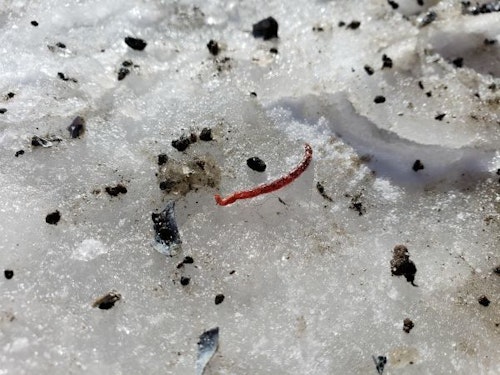For the better part of a century, spearers have flocked to Lake Winnebago in eastern Wisconsin in hopes of catching a glimpse of – and hopefully landing a spear in – a lake sturgeon. A tightly regulated harvest, immeasurable volunteer work, dedicated DNR staff and funds raised through license sales have created the largest and healthiest inland lake sturgeon population in the country. Recent estimates put the total population in the Winnebago system at over 40,000 adult fish. If you’re unfamiliar with Lake Winnebago, you might think with 40,000 fish in the lake it would be easy to spear one. Think again.
At first glance, the concept is relatively simple. You pick a spot, cut a hole in the ice, sit in your shanty and wait for a fish to swim by then throw your spear at it. Except, Lake Winnebago is around 132,000 acres, or roughly 5.7 billion square feet. Most spearing holes are only around 20 square feet (regulations require holes be no larger than 48 square feet.) To put that into perspective, if your home is 2,000 square feet, a comparatively sized hole would be about the size of a pinhead. I’ve heard sturgeon spearing compared to duck hunting through your chimney, and that’s not far off. But what if you could increase your odds of success?
There are a few things I look for while scouting for sturgeon prior to the start of the season. One major contributing factor to success rates is water clarity. Since sturgeon are primarily bottom feeders, it makes sense you would want to be able to see all the way to the bottom where you finally park or erect your shanty. Water clarity can be quite variable across the lake, dependent on runoff, algae growth and other factors. Though the lake is relatively shallow for its size with an average depth of around 15 feet, some years it can be difficult to find a location where you can see all the way down. But if you put in the work and drill enough holes, you can usually find one. A plain white coffee mug on a thin rope is often the tool of choice used when checking clarity.
The other thing to look for while scouting is food. The lake sturgeon diet in Lake Winnebago is predominately gizzard shad and chironomid larvae, also known as red worms and blood worms. Chironomids are more commonly known as lake flies and their larvae call the top layer of sediment at the bottom of Lake Winnebago home. For sturgeon, a densely populated worm bed is an all-you-can-eat buffet. Finding such a worm bed requires a bit of innovation and a lot of perspiration.

Wisconsin sells approximately 12,000 to 13,000 sturgeon spearing licenses each year. Since sturgeon spearing is such a niche sport, most supplies aren’t widely available – that includes scouting tools. You may hear them referred to as “worm dippers,” but I prefer “worm abductors” because they resemble a spaceship’s tractor beam coming down from above and taking the worms to a different world.
Whatever you call them, here’s how they work. There are two basic designs I’m familiar with. Both utilize a heavy pipe 2 to 6 inches in diameter with either a hinged flapper on the bottom or a one-way valve on the top. Both effectively work the same way, once lowered to the bottom of the lake into the mud, they hold mud and hopefully worms while being raised back up to the surface to be sorted through. The worm abductor I built didn’t require any special tools (although I did use a welder, you could get by without one) or components. It’s simply a length of 4-inch diameter steel pipe with a 4-inch to 2-inch flexible reducing coupling clamped onto the top, with a one-way sump pump valve inserted into the 2-inch end of the coupling. The valve allows water to exit the top of the device as it’s lowered down, then closes and keeps the mud in the pipe on the way up.
Once the pipe is removed from the water, the vacuum is lost, and the contents drop out. You can simply spread them out on the ice and pick through looking for red worms, but muddy spots on the lake can be unsightly and give away your location to other spearers. If you prefer a stealthier approach, you can empty the mud into a tub or quickly place a fine mesh colander over the hole to drop the mud into so you can sift out the red worms. I’ve heard of people finding as many as 75 worms in a single mud cake. Talk about an active worm bed!
Just like with hunting, putting in the time to scout before the sturgeon spearing season opens can greatly increase your odds of success. Dedicated spearers will spend as many hours and days as it takes to find a desirable spot, and sometimes watch the bottom with an underwater camera to verify the fish are there. Anybody can get lucky and spear a sturgeon, but those who put in the effort to scout ahead of time are usually rewarded with more consistent success.
I’m already counting down the hours to the start of the 2020 spearing season, but it’s not too late to build yourself a worm abductor and give yourself an edge. I’ll be spending opening weekend of the spearing season camping on the ice in my Eskimo ice shelter. Keep checking back for more stories on sturgeon spearing and winter camping on the ice.







